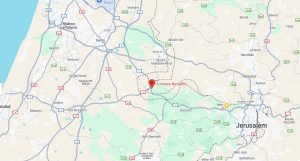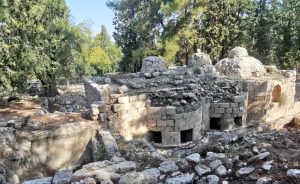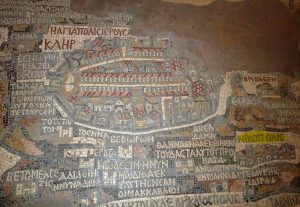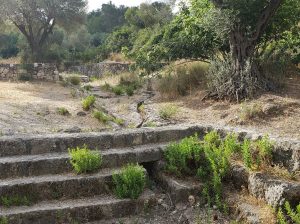“Rabbi Akiva says: I asked Rabban Gamliel and Rabbi Yehoshua a question in the market [itliz] of the town of Emmaus, where they went to purchase an animal for the feast of Rabban Gamliel’s son.” (Makkot 14a)
While the Gemara is not a history book or a travel guide, often, just by the way, we get fascinating bits of information about the Land of Israel. This is one of those places: three prominent rabbis meet while doing their shopping in the market of a town named Emmaus. This event must have occurred a few times (or left a great impression) since we have a similar incident in Hullin (91b) and another mention of our story as well as a few more questions in the Mishnah in Keritot (3:9).
The characters here need little introduction. Rabban Gamliel was the head of the Sanhedrin, Rabbi Yehoshua was his contemporary and Rabbi Akiva was their student. They lived in the late first-early second century CE, when the Rabbinic centers were in Yavneh and in Lod, two cities about equidistant from Jerusalem as well as from Emmaus. The three meet in the איטליז itliz. This word is modern Hebrew for a butcher shop but Professor Zeev Safrai explains that its original meaning was a large seasonal market. Unlike the יריד yarid, a seasonal fair which had a marked pagan and idolatrous element, the itliz was a more secular commercial opportunity, one that would have been more comfortable for the rabbis.
The itliz takes place in Emmaus (also spelled Emmaum and other variations). This town is located in the lowlands between the Judean Mountains and the coast, at a strategic point along major roads:

Emmaus is mentioned in numerous places in Rabbinic literature. In terms of its geography it was on the border between the (high) mountains to the east and the (lower) hills to the west:
“From Bet Ḥoron to Emmaus it is mountain, from Emmaus to Lod, lowland, from Lod to the sea, valley.” (Yerushalmi Sheviit 9:2)
The name Emmaus is a Greek corruption of a name that also appears in Rabbinic literature, Hamat. Hamat comes from the word ham, warm, and it means that there used to be hot springs in this place. There are other Hamats in Israel, most prominently Hamat Tverya near the Kinneret. Emmaus’ hot springs eventually dried up but we have evidence of a flourishing bathhouse culture in ancient times. The best preserved bathhouse in Israel was found here:

Heritage Conservation Outside The City Pikiwiki Israel, CC BY 2.5 <https://creativecommons.org/licenses/by/2.5>, via Wikimedia Commons
Because Emmaus was so strategically located, it was a center for conflict. It is located in the Ayalon Valley, famous for Joshua’s battle against the Canaanite generals when he commanded the sun to stand still (Joshua 10). Emmaus itself is first mentioned in the story of Chanukah, as the site of the Greek camp where Judah the Maccabee vanquished his enemies. Later it was a Roman encampment for the general Vespasian as he made his way to conquer Jerusalem in the Great Revolt. Hadrian also used Emmaus in his battles against the Bar Kokhba rebels. The Arab armies in the seventh century CE would have made Emmaus their main headquarters if not for a terrible plague that wiped out most of their army. And the Crusaders built a fortress right nearby, naming it La Touron de Chevaliers (the castle of the knights), a name eventually shortened to Latrun. In the War of Independence this area played a major role and it only became part of Israel’s borders after 1967.
Emmaus was a bustling and cosmopolitan commercial center. Samaritan inscriptions were found here, Roman pagans renamed it Nicopolis (city of victory)and as such it has a prominent place on the Byzantine Madaba map:

Nicopolis is highlighted, southwest (lower right) of Jerusalem
Deror Avi, CC BY-SA 3.0 <https://creativecommons.org/licenses/by-sa/3.0>, via Wikimedia Commons
Christians had their own Emmaus tradition. According to the New Testament (Luke 24), Emmaus is the place where Jesus was seen walking around after his death. Byzantine Christians built a church here, as did the Crusaders after them.
Besides the rabbis mentioned in our story, we have another story about a prominent rabbi in Emmaus. Rabbi Elazar ben Arach was considered to be the greatest disciple of Rabban Yochanan ben Zakkai, a “flowing spring” as his teacher describes him, full of original ideas and able to answer questions in the most appropriate manner (Avot 2:8). It is strange then that we have very few statements that have come down to us from this Tanna. The midrash explains that Rabbi Elazar ben Arach never fulfilled his early promise because he separated himself from his colleagues. We have two versions of this story. In one the fault lies with his wife:
“Rabbi Yoḥanan ben Zakkai had five disciples. As long as he was alive, they would sit before him. When he died, they went to Yavne, but Rabbi Elazar ben Arakh went to his wife in Emmaus, a place with good water and a beautiful view. He waited for them to come to him, but they did not come. When they did not come, he sought to go to them, but his wife did not allow him to do so. She said: ‘Who is in need of whom?’ He said to her: ‘They are in need of me.’ She said to him: ‘A leather container [of food] and mice, which typically goes to which; the mice to the container, or the container to the mice?’ He heeded her and remained until he forgot his learning.” (Kohelet Rabba 7:7)
Rabbi Elazar preferred the pleasures of the physical world to that of Torah while his wife was so concerned with his honor that she separated him from his contemporaries and his Torah suffered. Avot deRabbi Natan has a slightly different version of the story:
“When they all left, Elazar said: I am going to Damasit, a beautiful place with good, sweet water. They said: We will go to Yavneh, a place where there is an abundance of scholars who love the Torah. So he went to Damasit, the beautiful place with good, sweet water, and his reputation in Torah study diminished. And they went to Yavneh, the place where there was an abundance of scholars who all loved the Torah, and their reputations in Torah study grew.” (Avot deRabbi Natan 14:6)
In this version Emmaus is replaced with Damasit. This is Greek for a public building, perhaps a bathhouse, something we have already seen in Emmaus, the place of hot springs.
Many scholars place Rabbi Elazar ben Arach here, in the Emmaus in Judah. But others disagree. Emmaus was a half-day’s walk to Yavne, even less to Lod. We have seen that the rabbis congregated there. Why would Rabbi Elazar be isolated in Emmaus? Rabbi Yitzchak Goldhar and others suggest therefore that we are talking about a different Emmaus/Hamat, the one near the Kinneret. While this became a major Jewish center in the following generations, it WAS isolated during the Yavneh generation and Rabbi Elazar would probably have lost contact with his colleagues if he had relocated to there.
Since 1967 Emmaus, which became the Arab village of Imwas, has been part of Israel. The Arab residents fled during the Six-Day War and the site has been turned into a beautiful park called Park Canada which has reconstructions of the ancient water system that fed the city. Will an itliz be built here one day as well?

Reconstructed aqueducts at Park Canada, on the site of ancient Emmaus










